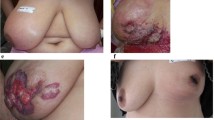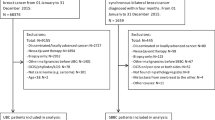Abstract
Approximately 6–15 % of breast cancer patients are diagnosed with primary ulcerated breast cancer (ULBC). ULBC is known to be associated with short recurrence free and poor overall survival. Therefore, the purpose of this study was to characterize ULBC and compare the histopathological findings with those of non-ulcerative breast cancer (NULBC). A total of 152 ULBCs were evaluated and compared to 304 consecutive non-ulcerated, age-matched breast malignancies. Patients mean age was 65 years (SD = 13.0 ULBC, SD = 14.0 NULBC). ULBC was associated with a higher rate of poorly differentiated tumors (p = <0.001), as well as larger tumor sizes (p = <0.001). As expected, the rate of axillary lymph node involvement was higher in ULBC patients (p = <0.001). In addition to that, ULBC was associated with a higher rate of triple negative breast cancer (p = 0.002), and higher Ki67 expression (p = <0.001). ULBC showed more aggressive histopathological features in comparison to NULBC which may contribute to the generally known poorer prognosis of women with ULBC.

Similar content being viewed by others
References
Guth U, Wight E, Schotzau A, Langer I, Dieterich H, Rochlitz C, et al. Breast carcinoma with noninflammatory skin involvement (t4b): Time to abandon an historic relic from the tnm classification. Cancer. 2005;104:1862–70.
Franceschini G, Terribile D, Magno S, Fabbri C, D’Alba PF, Chiesa F, et al. Update in the treatment of locally advanced breast cancer: a multidisciplinary approach. Eur Rev Med Pharmacol Sci. 2007;11:283–9.
Giordano SH. Update on locally advanced breast cancer. Oncologist. 2003;8:521–30.
Woodward WA, Strom EA, Tucker SL, McNeese MD, Perkins GH, Schechter NR, et al. Changes in the 2003 American joint committee on cancer staging for breast cancer dramatically affect stage-specific survival. J Clin Oncol. 2003;21:3244–8.
Favret AM, Carlson RW, Goffinet DR, Jeffrey SS, Dirbas FM, Stockdale FE. Locally advanced breast cancer: Is surgery necessary? Breast J. 2001;7:131–7.
El-Charnoubi WA, Svendsen JB, Tange UB, Kroman N. Women with inoperable or locally advanced breast cancer—what characterizes them? A retrospective review of 157 cases. Acta Oncol. 2012;51:1081–5.
Fiegl M, Kaufmann H, Steger GG. Ulcerative breast cancer: Case report and review of management. Breast J. 2001;7:422–6.
Ramirez AJ, Westcombe AM, Burgess CC, Sutton S, Littlejohns P, Richards MA. Factors predicting delayed presentation of symptomatic breast cancer: a systematic review. Lancet. 1999;353:1127–31.
Nederend J, Duijm LE, Voogd AC, Groenewoud JH, Jansen FH, Louwman MW. Trends in incidence and detection of advanced breast cancer at biennial screening mammography in the netherlands: a population-based study. Breast Cancer Res. 2012;14:R10.
Arnaout-Alkarain A, Kahn HJ, Narod SA, Sun PA, Marks AN. Significance of lymph vessel invasion identified by the endothelial lymphatic marker d2-40 in node negative breast cancer. Mod Pathol. 2007;20:183–91.
Hammond ME, Hayes DF, Wolff AC, Mangu PB, Temin S. American society of clinical oncology/college of american pathologists guideline recommendations for immunohistochemical testing of estrogen and progesterone receptors in breast cancer. J Oncol Pract. 2010;6:195–7.
Bartsch R, Bago-Horvath Z, Berghoff A, DeVries C, Pluschnig U, Dubsky P, et al. Ovarian function suppression and fulvestrant as endocrine therapy in premenopausal women with metastatic breast cancer. Eur J Cancer. 2012;48:1932–8.
Wolff AC, Hammond ME, Schwartz JN, Hagerty KL, Allred DC, Cote RJ, et al. American society of clinical oncology/college of american pathologists guideline recommendations for human epidermal growth factor receptor 2 testing in breast cancer. J Clin Oncol. 2007;25:118–45.
Goldhirsch A, Winer EP, Coates AS, Gelber RD, Piccart-Gebhart M, Thurlimann B, et al. Personalizing the treatment of women with early breast cancer: Highlights of the st gallen international expert consensus on the primary therapy of early breast cancer 2013. Ann Oncol. 2013;24:2206–23.
Barinoff J, Hils R, Bender A, Gross J, Kurz C, Tauchert S, et al. Clinicopathological differences between breast cancer in patients with primary metastatic disease and those without: a multicentre study. Eur J Cancer. 2013;49:305–11.
Blows FM, Driver KE, Schmidt MK, Broeks A, van Leeuwen FE, Wesseling J, et al. Subtyping of breast cancer by immunohistochemistry to investigate a relationship between subtype and short and long term survival: a collaborative analysis of data for 10,159 cases from 12 studies. PLoS Med. 2010;7:e1000279.
Macdonald SM, Harris EE, Arthur DW, Bailey L, Bellon JR, Carey L, et al. Acr appropriateness criteria(r) locally advanced breast cancer. Breast J. 2011;17:579–85.
Wieland AW, Louwman MW, Voogd AC, van Beek MW, Vreugdenhil G, Roumen RM. Determinants of prognosis in breast cancer patients with tumor involvement of the skin (pt4b). Breast J. 2004;10:123–8.
Haagensen C: Clinical classification of the stage of advancement of breast carcinoma. Diseases of the breast, ed 3rd ed. Philadelphia, W. B. Saunders Company, 1986.
Guth U, Wight E, Schotzau A, Langer I, Dieterich H, Rochlitz C, et al. A new approach in breast cancer with non-inflammatory skin involvement. Acta Oncol. 2006;45:576–83.
Gueth U, Wight E, Schoetzau A, Langer I, Dieterich H, Rochlitz C, et al. Non-inflammatory skin involvement in breast cancer, histologically proven but without the clinical and histological t4 category features. J Surg Oncol. 2007;95:291–7.
AUSTRIA S: Jahrbuch der gesundheitsstatistik; in Austria S (ed), Verlag Österreich GmbH, 2012.
Gennari R, Curigliano G, Rotmensz N, Robertson C, Colleoni M, Zurrida S, et al. Breast carcinoma in elderly women: Features of disease presentation, choice of local and systemic treatments compared with younger postmenopasual patients. Cancer. 2004;101:1302–10.
Biganzoli L, Wildiers H, Oakman C, Marotti L, Loibl S, Kunkler I, et al. Management of elderly patients with breast cancer: Updated recommendations of the international society of geriatric oncology (siog) and european society of breast cancer specialists (eusoma). Lancet Oncol. 2012;13:e148–160.
Yildirim E, Semerci E, Berberoglu U. The analysis of prognostic factors in stage iii-b non-inflammatory breast cancer. Eur J Surg Oncol. 2000;26:34–8.
Schoppmann SF, Bayer G, Aumayr K, Taucher S, Geleff S, Rudas M, et al. Prognostic value of lymphangiogenesis and lymphovascular invasion in invasive breast cancer. Ann Surg. 2004;240:306–12.
Pinder SE, Ellis IO, Galea M, O’Rouke S, Blamey RW, Elston CW. Pathological prognostic factors in breast cancer Iii Vascular invasion: Relationship with recurrence and survival in a large study with long-term follow-up. Histopathology. 1994;24:41–7.
Wildiers H, Van Calster B, van de Poll-Franse LV, Hendrickx W, Roislien J, Smeets A, et al. Relationship between age and axillary lymph node involvement in women with breast cancer. J Clin Oncol. 2009;27:2931–7.
Anders CK, Carey LA. Biology, metastatic patterns, and treatment of patients with triple-negative breast cancer. Clin Breast Cancer. 2009;9 Suppl 2:S73–81.
Yerushalmi R, Woods R, Ravdin PM, Hayes MM, Gelmon KA. Ki67 in breast cancer: Prognostic and predictive potential. Lancet Oncol. 2010;11:174–83.
Montagna E, Bagnardi V, Rotmensz N, Rodriguez J, Veronesi P, Luini A, et al. Factors that predict early treatment failure for patients with locally advanced (t4) breast cancer. Br J Cancer. 2008;98:1745–52.
de Azambuja E, Cardoso F, de Castro Jr G, Colozza M, Mano MS, Durbecq V, et al. Ki-67 as prognostic marker in early breast cancer: a meta-analysis of published studies involving 12,155 patients. Br J Cancer. 2007;96:1504–13.
Viale G, Regan MM, Mastropasqua MG, Maffini F, Maiorano E, Colleoni M, et al. Predictive value of tumor ki-67 expression in two randomized trials of adjuvant chemoendocrine therapy for node-negative breast cancer. J Natl Cancer Inst. 2008;100:207–12.
Acknowledgment
The authors want to thank Ms. Stefanie Mick for data input.
Conflicts of Interest
None
Authors’ contributions
MKT, CS, and CFS participated in the design, conception, and interpretation of the study as well as proof read and drafted the manuscript.
CS and MKT wrote the manuscript.
CS, MKT, GD, MB, ZBH, and KP helped with data collection.
MS participated in the design of the study and performed the statistical analysis.
Author information
Authors and Affiliations
Corresponding author
Additional information
Guarantor of Submission: The corresponding author is the guarantor of submission.
Rights and permissions
About this article
Cite this article
Staudigl, C., Bartova, M., Salama, M. et al. Histopathological characterization of ulcerated breast cancer and comparison to their non-ulcerated counterparts. Tumor Biol. 36, 3423–3428 (2015). https://doi.org/10.1007/s13277-014-2977-7
Received:
Accepted:
Published:
Issue Date:
DOI: https://doi.org/10.1007/s13277-014-2977-7




